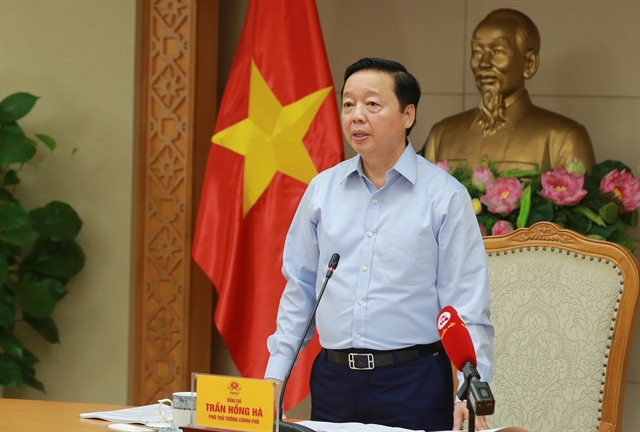 Economy
Economy


|
| Bạc Liêu Wind Power Plant in Vĩnh Trạch Đông Commune in the southern province of Bạc Liêu. The plant has a capacity of nearly 100 MW, including 62 turbines. VNA/VNS Photo Duy Khương |
HÀ NỘI — While experts say offshore wind power could be a good choice for Việt Nam to replace coal power, they are urging an extension of the feed-in tariff (FiT) programme.
Mark Hutchinson, chairman of the Global Wind Energy Council (GWEC)’s Southeast Asia Working Group, told local media that coal power plants around the world were being re-evaluated in terms of efficiency and cost, adding most countries in the world and financial institutions have announced a halt to investing in coal power.
Hutchinson said: “19 GW of coal power projects failed to raise finance, of which 8.6 GW will need to be deployed in the 2021-2030 period,” raising a problem for capital in coal power.
He said the era of building coal power projects based on foreign capital has ended for many places around the world including Việt Nam, which could only rely on domestic banks or the Government to implement new coal power projects.
The chairman said in the 2015-2021 period, Japan, South Korea and China were the largest "creditors" of coal power projects in Việt Nam, but all three countries have made commitments to stop investing in coal power while domestic credit institutions also have certain conditions that impacted such lending, saying: “If Việt Nam continues to rely on coal power, it will likely face many risks in terms of energy security.”
In this case, he said that investors needed to accept the new reality of no newly built coal-fired power plants, except for projects that have completed capital mobilisation.
At the same time, the current power shortage in China was a lesson about the need to diversify power sources, to avoid one source of energy accounting for too large a proportion, which greatly affects energy security. Accordingly, it is necessary to diversify power sources such as offshore wind power, onshore wind power, solar power and hydroelectricity as well as to strengthen the energy storage system.
"For the time being, energy storage technology is mainly based on lithium batteries, but in the future it will be possible to use hydrogen storage batteries with better, more modern technology," said Hutchinson.
From a credit institution's perspective, Patrick R. Jakobsen, Chief Underwriter of Denmark's Export Credit Agency, EKF, said financial arrangements for coal power were becoming taboo for financial institutions, so “it will be difficult for any financial institution to provide new coal power projects.”
He mentioned anti-coal financing regulations in China and the United Kingdom as prime examples, adding 34 countries and territories have joined the coalition to provide electricity without coal; of which, 1,600 GW of planned coal capacity has been cancelled or shelved over the years.
While China and India were the two countries topping the list of countries cancelling and suspending coal power, he said: “Việt Nam is at a pivotal stage, it needs to make a choice. If we continue with coal power, it will be difficult to arrange finance.”
“Or if it continues promoting renewable energy such as offshore wind power, it will have the opportunity to access many financial resources in the world,” said Jakobsen.
According to GWEC, offshore wind power is considered to have long-term economic benefits and help balance trade by reducing coal and gas imports.
Hutchinson said that offshore wind power had the highest power factor of variable renewables, on par with the best gas power plants. Offshore wind power capacity in the UK for example was around 55 per cent, which was an attractive coefficient when financial units decide to invest in the project.
According to data, offshore wind power in Việt Nam was expected to reach 10 GW by 2030, while the investment costs have decreased by 67 per cent globally between 2013 and 2020. It is expected that in the next five years, costs will decrease by another 30 per cent.
GWEC calculated that the first 4-5 GW of offshore wind power in Việt Nam will require an investment of between US$10 billion and $12 billion, however as it is an inexhaustible resource that does not need to spend money to import fuels such as coal power and gas after construction, it could help reduce the cost of fuel by $650-800 million.
To such factors, Hutchinson considered initial support for the power is essential to attract investors of this type in Việt Nam, urging the Vietnamese government to postpone the feed-in tariff (FiT) deadline for wind projects that would fall on November 1 by at least another six months.
GWEC said due to pandemic-related obstacles and delays, most onshore wind projects currently in the pipeline will not complete construction in time to meet the deadline for tariff access.
As of August 2021, an industry survey conducted by GWEC estimates that 4,000MW of mainly onshore wind projects in Việt Nam were severely challenged by these extenuating circumstances and are now at risk of missing the November deadline for the wind FiT.
Mentioning policies, Jakobsen said: “Việt Nam is considered havingg large wind resources, but the lack of mechanisms will cause financial resources to be limited. If there are supportive policies from the Government, financial sources for renewable energy, including wind power, will become abundant. This is an important time for Viet Nam to choose green energy, transition to clean energy or continue with electricity.”
According to the Prime Minister's Decision No. 39/2018/QD-TTg on the mechanism to support the development of wind power projects in Việt Nam, the FiT price mechanism for wind power will expire after this month and the Ministry of Industry and Trade would study and propose a bidding plan and determine prices for wind power projects.
Asia Regional Director of GWEC, Liming Qiao, said to move from the FiT price mechanism to the bidding mechanism, there needs to be a careful transition period as it will take about two years to develop a suitable bidding mechanism, adding: "Such conversion mechanisms can keep investors in the process of waiting to be converted to bidding."
GWEC leaders thought if there was no extension of the time to apply the FiT pricing mechanism, these projects will suffer losses and harm the development of sustainable energy in Việt Nam.
Earlier, local media estimated 4,000MW of wind projects translate to around $6.7 billion in investment that would significantly benefit local authorities and communities. — VNS









